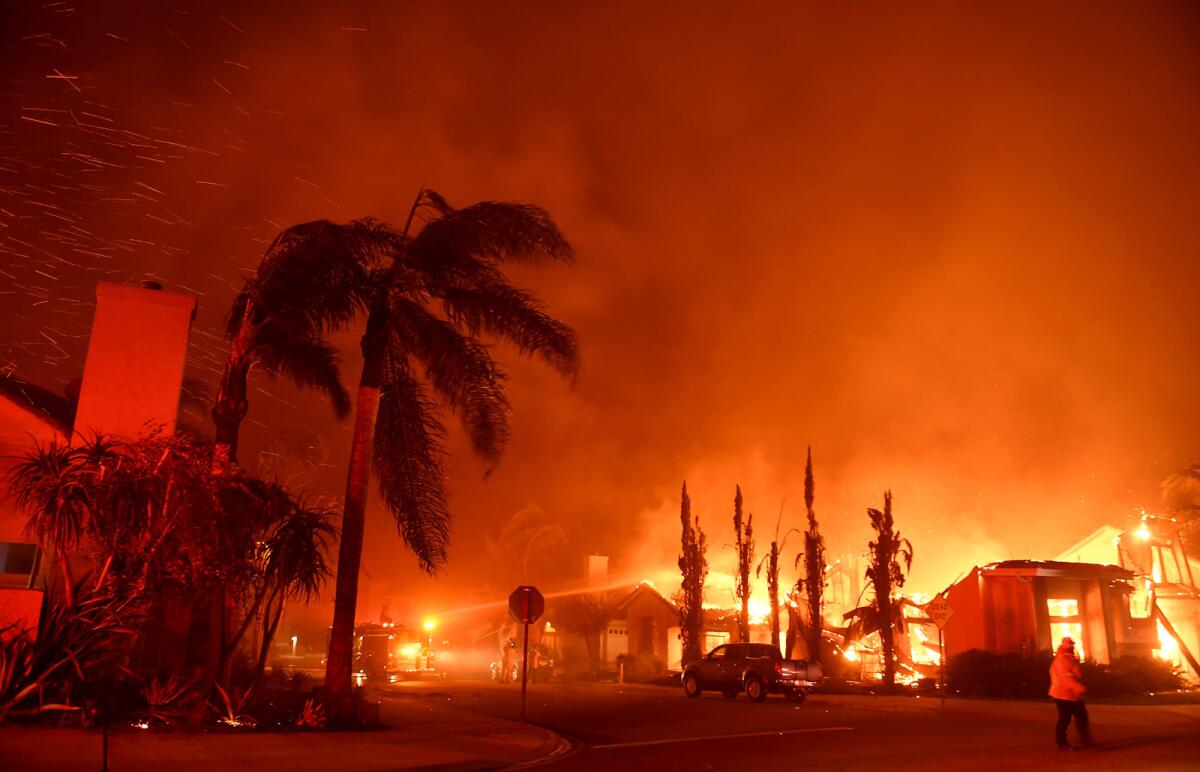Will California ever learn anything from its wildfires?

- Share via
To anyone who’s followed the news of wildfires in California in recent years — or this week’s Tick fire — the 200-page report commissioned by Los Angeles County officials on last year’s Woolsey fire will sound terrifyingly familiar.
The Woolsey fire, which burned nearly 100,000 acres from Oak Park to Malibu, was bigger, faster and more destructive than anyone expected, according to the county’s report. Even in a region accustomed to and prepared for fires, the blaze shocked and overwhelmed authorities. There simply weren’t enough fire engines or water-dropping aircraft to match the scale and speed of the fire. Residents, so used to firefighters saving their homes, complained that they couldn’t get an engine to come to their street. And people fleeing the fire were trapped in clogged evacuation routes.
In the end, the Woolsey fire joined the growing list of monstrous wildfires in California that are apparently becoming the norm. Five of California’s deadliest wildfires have occurred during the last two years. And six of the most destructive wildfires, in terms of structures lost, occurred over the last 10 years.
Now Los Angeles County is dealing with a new fire in the Santa Clarita area that has prompted the evacuation of at least 40,000 people. And like last year, state fire resources are stretched thin as agencies fight another conflagration in Northern California and additional wildfires throughout Southern California.
It should be crystal clear by now that California needs to make major changes in the way communities prepare for these inevitable blazes. The warming climate is creating conditions that fuel more devastating wildfires as more and more people are moving into the wildland-urban interface, where homes and offices abut foothills, forests or other open land.
Yet lawmakers at all levels of government still refuse to fully grapple with the challenges posed by the new normal. Can we make existing homes in fire zones safer and if so, how? What responsibility and obligations do residents in high-fire-risk areas bear for their own safety and that of their property? Are there some areas where it’s too dangerous to rebuild? Why, when we know the danger and the cost, do we keep allowing new subdivisions to march deeper into high-fire-risk areas?
Support our journalism
Instead, the focus has been on firefighting, equipment and brush clearance. The county’s post-Woolsey fire review was requested by Supervisor Sheila Kuehl to help agencies understand what happened and how to minimize damage in future events. The report lays out dozens of practical recommendations for government agencies to better coordinate and respond to the next disaster. It’s a smart exercise. County leaders are talking about a tax increase to expand the fire department.
But the report only briefly touches on the harder policy decisions that we ignore at our collective peril: “We cannot expect that all population growth in Very High or High Fire Hazard Severity areas can be protected simply by increasing resiliency to wildfire and by adding more fire engines,” the report says.
Of course existing homes have to become more resilient in the face of wind-driven blazes. And California may need to invest in more firefighting personnel and equipment to deal with the worsening fires. But it is folly to think that stricter building codes and more fire engines can eliminate the danger we create by building and rebuilding in high-fire-risk areas.
Lawmakers can’t necessarily stop people from rebuilding on land they own, given the 5th Amendment’s protections for property owners. But California could buy out owners to prevent them from rebuilding in high-risk areas. Cities and state agencies are talking about “managed retreat” — or relocating threatened homes — from communities facing coastal erosion or flooding. Why is there not a similar policy discussion in areas that repeatedly burn?
Nor is there any serious discussion of limiting new development in high fire-risk areas. In fact, local leaders in L.A. County, San Diego County and throughout the state are still approving massive new subdivisions on hillsides in the urban fringe — exactly the areas that are most likely to burn and burn again. And for existing homes, there are few, if any, requirements for home hardening or maintenance, and little assistance for homeowners who want to do it voluntarily.
Gov. Gavin Newsom has dismissed the idea of blocking development in fire-prone areas, saying such restrictions would be counter to California’s “pioneering spirit.” Perhaps. But the pioneers didn’t face subdivisions aflame or tens of thousands of neighbors trying to evacuate at the same time.
The death and destruction caused by recent wildfires should have served as reminder enough that California can’t keep sprawling into dangerous wildfire terrain. So far, California leaders have refused to act. What will it take?
More to Read
A cure for the common opinion
Get thought-provoking perspectives with our weekly newsletter.
You may occasionally receive promotional content from the Los Angeles Times.









